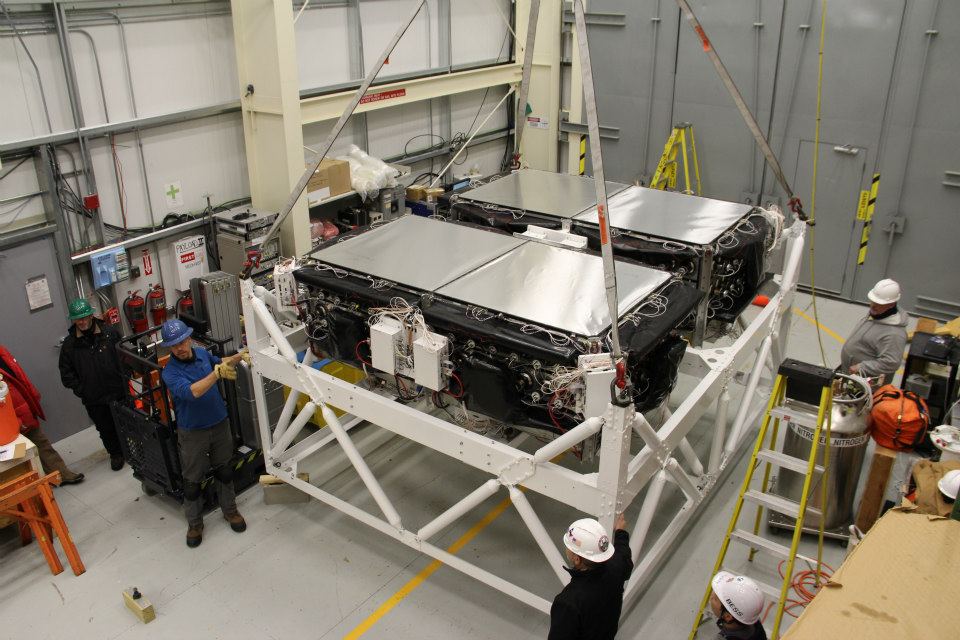Purpose of the flight and payload description
The SuperTIGER instrument was developed to accurately measure the abundances of ultra-heavy, trans-iron Galactic Cosmic Ray nuclei. This instrument is an enlarged and higher resolution version of the earlier TIGER instrument that was flown over Antarctica twice in early 2000's.
SuperTIGER was designed for simple assembly, easy launch, and used no consumables. SuperTIGER has the largest geometric acceptance readily achievable for an instrument meeting the weight limits for flight on a standard stratospheric balloon. The full instrument weight was 1770 kg. SuperTIGER incorporated a detector suite selected for excellent charge resolution of ultra-heavy galactic cosmic-ray (UHGCR) nuclei, minimal nuclear interactions, minimum weight, and large geometric acceptance. The techniques used to measure charge and energy were identical to those employed by TIGER, but the implementation has been improved.
SuperTIGER (as did TIGER) used plastic scintillators, acrylic Cherenkov counters, and silica-aerogel Cherenkov counters to determine the element species and kinetic energy of incident particles. Scintillating optical fiber hodoscopes at the top and bottom of the detector stack measured the trajectories of particles transiting the instrument for angle corrections and mapping.
For SuperTIGER the scintillator and Cherenkov detector enclosures were floored with an ultra-low-density foam/aluminum-foil composite developed at NASA GSFC, which was also used to support the hodoscope. The tops of the scintillator, Cherenkov, and hodoscope enclosures were made of thin Al foil.
To improve detector performance and add redundancy for enhanced reliability, SuperTIGER was divided into two completely independent modules, as shown in the figure above. Each module can be mechanically disassembled to a half-module subsystem to enable recovery with any available aircraft in Antarctica.
Video footage of the launch
Details of the balloon flight

Balloon launched on: 12/8/2012 at 20:45 utc
Launch site: Williams Field, McMurdo Station, Antarctica
Balloon launched by: Columbia Scientific Balloon Facility (CSBF)
Balloon manufacturer/size/composition: Zero Pressure Balloon Raven Aerostar - W39.57 (39.570.000 cuft)
Flight identification number: 637N
End of flight (L for landing time, W for last contact, otherwise termination time): 2/1/2013 at 22:17 utc
Balloon flight duration (F: time at float only, otherwise total flight time in d:days / h:hours or m:minutes - ): 55 d 2 h 32 m
Landing site: At coordinates 82° 14.75 S, 81° 54.83 W, Antarctica.
The instrument had its first flight over Antarctica in December 2012, totalling 55 days aloft and performing 2.7 revolutions around the South Pole. It was terminated in febraury 2013 and landed on the West Antarctic Ice Sheet at 82.24º S 81.91º W. Due to logistics complications and the cancellation of the balloon launch campaign in 2014, it was left in the ice during two years before being recovered in early 2015.
It performed well during its record 55-day Antarctic flight, returning data on over 50 million cosmic-ray nuclei.
External references
- Super-Tiger website Washington University, Department of Physics
- Galactic Cosmic Ray Origins and OB Associations: Evidence from SuperTIGER Observations of Elements 26Fe through 40Zr The Astrophysical Journal, Volume 831, Number 2
- Remote recovery - Team ventures to hinterland of Antarctica to retrieve SuperTIGER instrument Article in the Antarctic Sun Online Magazine
- The SUPERTIGER Instrument: Measurement of Elemental Abundances of Ultra-Heavy Galactic Cosmic Rays The Astrophysical Journal , 788:18, 2014 June 10
11725If you consider this website interesting or useful, you can help me to keep it up and running with a small donation to cover the operational costs. Just the equivalent of the price of a cup of coffee helps a lot.







